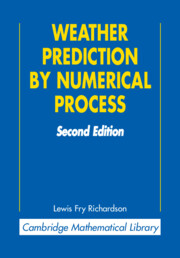Book contents
- Frontmatter
- FOREWORD
- Contents
- PREFACE
- GUIDING SIGNS
- CHAP. I SUMMARY
- CHAP. II INTRODUCTORY EXAMPLE
- CHAP. III THE CHOICE OF COORDINATE DIFFERENCES
- CHAP. IV THE FUNDAMENTAL EQUATIONS
- CHAP. V FINDING THE VERTICAL VELOCITY
- CHAP. VI SPECIAL TREATMENT FOR THE STRATOSPHERE
- CHAP. VII THE ARRANGEMENT OF POINTS AND INSTANTS
- CHAP. VIII REVIEW OF OPERATIONS IN SEQUENCE
- CHAP. IX AN EXAMPLE WORKED ON COMPUTING FORMS
- CHAP. X SMOOTHING THE INITIAL DATA
- CHAP. XI SOME REMAINING PROBLEMS
- CHAP. XII UNITS AND NOTATION
- INDEX OF PERSONS
- INDEX OF SUBSIDIARY SUBJECTS
FOREWORD
Published online by Cambridge University Press: 06 July 2010
- Frontmatter
- FOREWORD
- Contents
- PREFACE
- GUIDING SIGNS
- CHAP. I SUMMARY
- CHAP. II INTRODUCTORY EXAMPLE
- CHAP. III THE CHOICE OF COORDINATE DIFFERENCES
- CHAP. IV THE FUNDAMENTAL EQUATIONS
- CHAP. V FINDING THE VERTICAL VELOCITY
- CHAP. VI SPECIAL TREATMENT FOR THE STRATOSPHERE
- CHAP. VII THE ARRANGEMENT OF POINTS AND INSTANTS
- CHAP. VIII REVIEW OF OPERATIONS IN SEQUENCE
- CHAP. IX AN EXAMPLE WORKED ON COMPUTING FORMS
- CHAP. X SMOOTHING THE INITIAL DATA
- CHAP. XI SOME REMAINING PROBLEMS
- CHAP. XII UNITS AND NOTATION
- INDEX OF PERSONS
- INDEX OF SUBSIDIARY SUBJECTS
Summary
Accurate weather forecasts based on computer simulation are now produced as a routine, and have reached such a level of reliability that the rare forecast failures evoke a strong reaction in the media and amongst users. Numerical simulation of an ever-increasing range of geophysical phenomena is adding enormously to our understanding of complex processes in the Earth system. The consequences for mankind of ongoing climate change will be far-reaching. Earth System Models are capable of replicating climate regimes of past millennia and are the best means we have of predicting the future of our climate.
The basic ideas of numerical forecasting and climate modelling date from long before the first electronic computer was constructed. These techniques were first developed by Lewis Fry Richardson about a century ago, and set down in this book. Richardson was concerned with establishing a scientific method of predicting the weather. Since he was not aware of the dominant role of dynamics in the short term, he gave as much weight to small-scale physical processes as to large-scale dynamics. As a result, the algorithm he produced amounts, in essence, to a general circulation model of the atmosphere, capable of describing both weather and climate.
The first explicit analysis of the weather prediction problem from a scientific viewpoint was undertaken by the Norwegian scientist Vilhelm Bjerknes. Richardson's forecasting scheme amounts to a precise and detailed iniplementation of Bjerknes' programme.
Information
- Type
- Chapter
- Information
- Weather Prediction by Numerical Process , pp. v - viiiPublisher: Cambridge University PressPrint publication year: 2007
